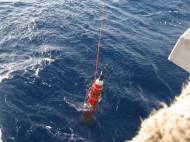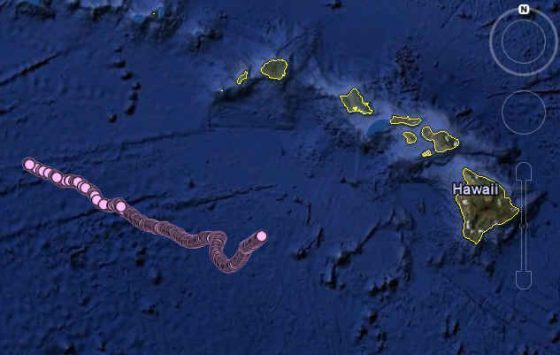Harvesting ocean thermal energy – SOLO-TREC autonomous underwater vehicle
 Researchers at NASA’s Jet Propulsion Laboratory and the Scripps Institution of Oceanography, have successfully demonstrated the first robotic underwater vehicle to be powered entirely by natural, renewable, ocean thermal energy. The Sounding Oceanographic Lagrangrian Observer Thermal RECharging (SOLO-TREC) autonomous underwater vehicle uses a thermal recharging engine powered by the natural temperature differences found at different ocean depths.
Researchers at NASA’s Jet Propulsion Laboratory and the Scripps Institution of Oceanography, have successfully demonstrated the first robotic underwater vehicle to be powered entirely by natural, renewable, ocean thermal energy. The Sounding Oceanographic Lagrangrian Observer Thermal RECharging (SOLO-TREC) autonomous underwater vehicle uses a thermal recharging engine powered by the natural temperature differences found at different ocean depths.
“People have long dreamed of a machine that produces more energy than it consumes and runs indefinitely,” said Jack Jones, a JPL principal engineer and SOLO-TREC co-principal investigator. “While not a true perpetual motion machine, since we actually consume some environmental energy, the prototype system demonstrated by JPL and its partners can continuously monitor the ocean without a limit on its lifetime imposed by energy supply.”
SOLO-TREC draws upon the ocean’s thermal energy as it alternately encounters warm surface water and colder conditions at depth. The energy is gathered with the carefully selected waxy substances known as phase-change materials that are contained in 10 external tubes, which house enough material to allow net power generation. As the float surfaces and encounters warm temperatures, the material melts and expands and when it dives and enters cooler waters, the material solidifies and contracts. The expansion of the wax pressurizes oil stored inside the float. This oil periodically drives a hydraulic motor that generates electricity and recharges the vehicle’s batteries. Energy from the rechargeable batteries powers the float’s hydraulic system, which changes the float’s volume (and hence buoyancy), allowing it to move vertically.
So far, SOLO-TREC has completed more than 300 dives from the ocean surface to a depth of 500 meters (1,640 feet). Its thermal recharging engine produced about 1.7 watt-hours, or 6,100 joules, of energy per dive, enough electricity to operate the vehicle’s science instruments, GPS receiver, communications device and buoyancy-control pump.
The SOLO-TREC demonstration culminates five years of research and technology development by JPL and Scripps and is funded by the Office of Naval Research. JPL developed the thermal recharging engine, building on the buoyancy engine developed for the Slocum glider by Teledyne Webb Research, Falmouth, Mass. Scripps redesigned the SOLO profiling float and performed the integration. The 84-kilogram (183-pound) SOLO-TREC prototype was tested and deployed by the JPL/Scripps team on Nov. 30, 2009, about 161 kilometers (100 miles) southwest of Honolulu.
The performance of underwater robotic vehicles has traditionally been limited by power considerations. The international Argo array, supported in part by the National Oceanic and Atmospheric Administration, measures temperature, salinity and velocity across the world’s ocean. NASA and the U.S. Navy also plan to apply this thermal recharging technology to the next generation of submersible vehicles.










Leave your response!